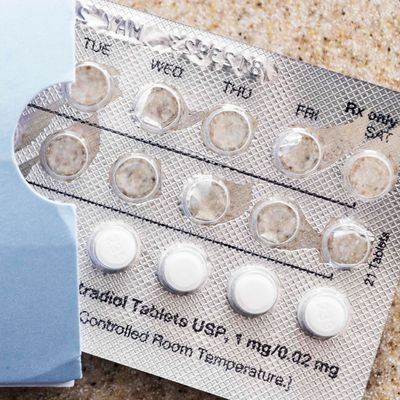
On Wednesday, a board of FDA advisors voted unanimously to allow Opill, a progestin-only birth control pill, to be sold over the counter. If the FDA signs off on the decision, Opill will be the first oral contraceptive available OTC in the U.S. and could hit shelves as soon as this summer. Medical professionals have publicly supported making birth-control pills available OTC since at least 2012, and the Pill is currently sold that way in more than 100 countries. Yet it wasn’t until July 2022 that Opill’s manufacturer, Paris-based pharmaceutical company HRA Pharma, announced that it had submitted an FDA approval request. Why has it taken this long?
While HRA Pharma said the timing of its submission — within weeks of the Supreme Court’s decision to strike down Roe v. Wade — was a coincidence, the Dobbs ruling has undoubtedly heightened the stakes on contraceptive access. Clarence Thomas suggested that birth control could be next on the chopping block — but even while it remains legal, there are many obstacles to access. In the U.S., you need a prescription to get the Pill, which typically requires that you go to a doctor’s office at least once a year. A 2011 study found that 29% of people who’d ever tried to get a birth-control-pill prescription had trouble doing so. The need for a prescription is a nuisance for anyone, but it presents a particular challenge for those who are uninsured or don’t speak English. Not all doctors will prescribe the Pill — Catholic health-care facilities generally don’t allow their physicians to prescribe birth control at all, citing “conscientious objection” laws — and a number of states require minors to have parental permission to get a prescription.
Meanwhile, the U.S. has a significantly higher rate of unintended pregnancies than most developed countries. This tends to disproportionately impact young, low-income people of color. With abortion bans taking hold in states across the country, contraceptive access is more crucial than ever — and making the Pill available OTC seems like an obvious step.
.
Oral contraceptives are considered low-risk.
In order for a medication to be deemed safe for over-the-counter sales, pharmaceutical companies are required to prove that customers can monitor themselves to catch any adverse side effects associated with the medication. “Nothing that’s available over the counter is 100 percent safe,” says Aparna Sridhar, an associate clinical professor in obstetrics and gynecology at UCLA Health. Ibuprofen can very rarely cause gastrointestinal bleeding; Tylenol misuse can ultimately lead to liver failure. The FDA has to be convinced that any lay person taking medication without the supervision of a care provider would know if something’s wrong and when to seek medical attention. Manufacturers have to prove that people of all reading levels can use the medication’s label to self-screen — i.e., decide whether it’s safe to take it with co-existing conditions like pregnancy, smoking, old age, other medications, or migraines.
When it comes to the Pill, “there’s very little that needs to be monitored,” says Frances Grimstad, a pediatric and adolescent gynecologist at Boston Children’s Hospital, adding that as long as people taking the Pill have annual checkups with a general practitioner, there’s little chance they’d be unknowingly experiencing adverse effects.
The biggest risk associated with oral contraceptives is blood clots, which are still extremely rare — and generally a far lower risk than clots while pregnant or in the postpartum period. According to Sridhar, it’s pretty hard not to notice the symptoms. “If you’re really having a clot in your leg or your lung, that’s not something that will just be missed,” she says, adding, “Education around that can easily be administered in the product label.” Similarly, Sridhar says a simple questionnaire could be used to ask consumers questions about their age, recent or current pregnancies, breastfeeding, and medical history to help them decide whether they can safely take the Pill.
.
The medical field largely agrees that the Pill should be available without a prescription.
Over the past decade, the American Medical Association, American College of Obstetricians and Gynecologists, and American Academy of Family Physicians have all come out in favor of making the Pill available to people of all ages without a prescription. “There’s a robust set of data that shows just how safe birth control over the counter can be,” Grimstad says. ACOG first published data supporting over-the-counter sales in 2012. That data included evidence that, given proper labeling, adolescents are just as capable of making decisions about their own use of the Pill as those over 16. Despite fear-mongering about making the Pill available to minors, adolescents are one of the groups most likely to benefit from over-the-counter access. On top of the disruptions of an unplanned pregnancy, teenagers who carry a child to term face much higher rates of pregnancy complications than adults. Prescriptions show up on family insurance bills — just one of the reasons it can be harder for teenagers to safely access contraception. “Adolescents face far greater barriers than adults do in this sphere,” Grimstad says, “and the data shows this would greatly improve adolescent accessibility to birth control.”
Sridhar told me there’s concern that, “If you give people access to over-the-counter hormonal contraception, they may not show up in the doctor’s office for other things like pap smears, breast exams, and STI tests.” Currently, though, none of those procedures are required in order to get physician-prescribed birth-control pills.
.
Over-the-counter access doesn’t necessarily mean universal access.
The biggest question surrounding oral contraceptives is cost, which is currently one of the most commonly cited barriers to contraception access. Offering the Pill over the counter doesn’t necessarily offer a cure-all for that. Most insurance plans, including Medicare and Medicaid, include full coverage of at least some brands of prescribed oral contraception at no cost — as is mandated by the Affordable Care Act. Without insurance, prescribed birth-control pills cost between $20 and $50 per one-month pack.
Moving birth-control pills to non-prescription status could complicate how insurance covers them. Ideally, they’d be fully reimbursed by a plan that covers over-the-counter drugs. But the ACA’s requirement, which says health plans must cover an FDA list of 18 “female-controlled” contraception methods, still allows insurance companies to request a prescription before agreeing to cover certain methods that are sold over the counter including spermicide and Plan B. And even that mandate has holes, including exceptions for religious employers like churches and church-affiliated schools, which aren’t required to offer health plans that cover contraception.
HRA Pharma sells a similar progestin-only pill over the counter in the U.K. for £9.95 (about $12) per pack, which is not covered by the NHS’s health care. There’s still no news on how much the company plans to charge, but it has repeatedly indicated that it plans to make its U.S. version “very affordable for consumers.”
.
The U.S. is way behind other countries when it comes to birth control availability.
It’s not entirely clear why it has taken so long for a pharmaceutical company to file for FDA approval to make birth-control pills available OTC. While there’s extra attention to contraceptive accessibility now, Grimstad says that, “OB/GYNs have been studying this from every critical angle since the early 2000s — if not before.” Cadence Health, which makes a combination pill that includes estrogen as well as progestin that it’s hoping to sell over the counter, claims the FDA has caused several holdups in its testing process, and as a result, it hasn’t yet filed an application for OTC. One executive at the company said the FDA allegedly put Cadence’s “actual use trial,” which tests how consumers use the medication in real life, on hold after asking it to add new details to the drug-safety label. When asked about HRA Pharma and Cadence’s efforts in December, the FDA declined to comment on each company but maintained that the time it takes to test a drug before applying to make the switch from prescription to non-prescription is “determined by the company, not by the FDA.”
Cadence is not the first to claim that the FDA may have stood in the way of making birth control more widely accessible. In 2005, Susan Wood resigned from her position as the FDA’s director of women’s health, claiming the agency was deliberately obstructing access to Plan B and deviating from its standard procedures because of the political nature of the decision. The FDA first cleared emergency contraception for over-the-counter sales to people 18 and older in 2006 and was ordered to lower the age restriction to 17 in 2009. In 2011, the agency was poised to remove the age restriction altogether but, in a rare step, Obama-appointed health secretary Kathleen Sebelius overruled the decision out of concern for giving minors access to emergency contraception without parental consent. (Obama supported Sebelius’s decision, arguing that “as the father of two daughters,” he was not comfortable with children younger than 17 being able to buy emergency contraception.) In 2013, ten years after the initial application was submitted, the FDA finally approved Plan B One-Step for over-the-counter sales at all ages after a judge ruled that the age restrictions were “arbitrary, capricious, and unreasonable.”
Now that the experts have voted, the FDA is expected to make a decision this summer, meaning Opill could be on shelves by the end of the year. Given how widely available the Pill is in other countries, we’re way past due.


